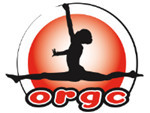 Rhythmic Gymnastics is one of the most beautiful and precise Olympic Sports. It is a combination of the dynamics and flexibility of gymnastics, the technical knowledge of ballet, and the self-expression and rhythm of modern dance. Unmatched for its elegant, expressive, precise and graceful movements, Rhythmic Gymnastics is choreographed to music and accompanied by colourful hoops, balls, ropes, ribbons, and clubs. The benefits of Rhythmic Gymnastics to girls in their formative years include physical fitness, self-discipline, positive self-esteem, lasting friendships, team skills, fun and a healthy lifestyle that the gymnast will sustain for life. Unlike Artistic Gymnastics, Rhythmic Gymnastics is currently performed in official competition by women only. Competitors use small pieces of hand apparatus – Rope, Hoop, Ball, Clubs and Ribbon as an extension of their bodies in routines always accompanied by music. The performance takes place on a carpeted mat that is 13m. x 13m. It is slightly cushioned, but certainly not to the extent of a ‘spring’ floor used in Artistic Gymnastics.
Rhythmic Gymnastics is one of the most beautiful and precise Olympic Sports. It is a combination of the dynamics and flexibility of gymnastics, the technical knowledge of ballet, and the self-expression and rhythm of modern dance. Unmatched for its elegant, expressive, precise and graceful movements, Rhythmic Gymnastics is choreographed to music and accompanied by colourful hoops, balls, ropes, ribbons, and clubs. The benefits of Rhythmic Gymnastics to girls in their formative years include physical fitness, self-discipline, positive self-esteem, lasting friendships, team skills, fun and a healthy lifestyle that the gymnast will sustain for life. Unlike Artistic Gymnastics, Rhythmic Gymnastics is currently performed in official competition by women only. Competitors use small pieces of hand apparatus – Rope, Hoop, Ball, Clubs and Ribbon as an extension of their bodies in routines always accompanied by music. The performance takes place on a carpeted mat that is 13m. x 13m. It is slightly cushioned, but certainly not to the extent of a ‘spring’ floor used in Artistic Gymnastics.
The question has often been asked of Rhythmic Gymnastics: Is it Dance? Is it Art? Or is it Sport? In reality it is a unique combination of the best of all three worlds. The essence of Rhythmic Gymnastics is self-expression. In the absence of extremely difficult acrobatic elements used in Artistic Gymnastics, the movements in Rhythmic Gymnastics are elegant, expressive, precise and graceful. Athletes require a full range of flexibility throughout the entire body in addition to explosive power. Both factors combined allow athletes to maintain perfect body alignment in leaps, balances, pirouettes and other intricate body movements. Athletes display coordination and cohesion in their use of the hand apparatus with rhythmic sensibility while taking risks with technical precision. The highest-level competitors take great pride in their original compositions as they appear to become one with the music and the apparatus.
There are two different types of competition in Rhythmic Gymnastics: Individual and Group. In the Group Competition 5 athletes work together as one. They use one of the hand apparatus or a combination of two different pieces (i.e. Ribbons and Hoops). To watch the combination of 5 different personalities meld together to perform intricate compositions involving highflying throws and exchanges is truly thrilling. The element of cooperation among the athletes is essential resulting in a breathtaking, harmonious unit.
In 1984, Rhythmic Gymnastics achieved full Olympic status at the Games in Los Angeles. The first ever Olympic Gold Medal in Rhythmic Gymnastics was won by Canada’s Lori Fung.
